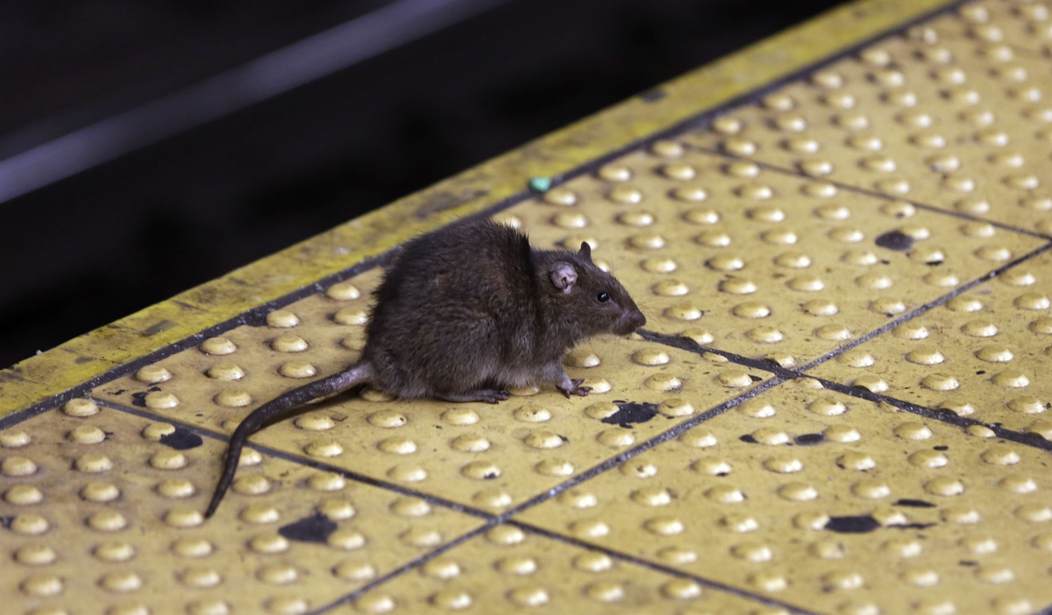I've maintained for many years that cities aren't good for people.
Part of that is my own rural bias talking, of course. While I lived in a suburb of a major city for many years (Denver) I grew up in a small town/rural environment and live in a rural setting now. Even so, it always has seemed to me that cramming millions of people into a hive-like New York isn't good for people in general, and I think the various behavioral pathologies we see in America's major urban areas today bear that view out. But now, in New York City, it's not just behavioral illnesses, but real ones, spread by a pest that has vexed humanity since the very beginning of, well, humanity — rats.
A life-threatening bacterial infection typically spread through rat urine sickened a record number of people in New York City last year—and this year looks on track for another all-time high, the NYC Department of Health and Mental Hygiene reports.
The infection is leptospirosis, which can cause a range of symptoms, including non-specific ones like fever, headache, chills, muscle aches, vomiting, diarrhea, and cough. But, if left untreated, can become severe, causing kidney failure, liver damage, jaundice, hemorrhage, bloody eyes (conjunctival suffusion), respiratory distress, and potentially death.
The bacteria that causes it—spirochete bacteria of the genus Leptospira—infect rats, which shed the bacteria in their urine. The germs jump to people through direct contact with open wounds or mucous membranes.
Note that last sentence: Rats shed the bacteria in their urine. This disease is spread by rat pee. By people ingesting (for the most part) rat pee.
Now, from my time as a pest-control guy (granted, that was one summer in the mid-80s), I learned that rats and mice don't pee the way humans do. Unlike most mammals, they don't feel the urge to stop and let fly. Instead, they basically leave a little trail of pee droplets wherever they go, contaminating everything they come across. And in a city like New York, they have lots of opportunities.
What's disturbing about this latest disease is the trendline. From 2001 to 2020, there were an average of three leptospirosis cases per year. In 2023, there were 24. In a city the size of New York, granted, that doesn't seem so great, but when you consider the trends — and how many people from who-knows-where are crowding into that city right now — the sudden spread of one rat-borne disease raises the possibility of others.
See Related: Salon Gaslights Readers, Claims Attacks on Women in NYC Were 'Unleashed by MAGA'
Over 1,000 African Illegal Immigrants Swarm NY City Hall, Falsely Promised Work Permits
Here's the inevitable comment:
That number of cases so far this year is concerning given that Leptospira bacteria are "fragile," as the NYC health department puts it. They die quickly in the freezing temperatures of winter and the dry heat of summer. Their main time to thrive is in warm, moist conditions. Last year, the months with the most cases were June and October. The health department noted that climate change, which is causing excessive rain and unseasonably warm temperatures, may be partly driving the uptick in cases.
So, climate change. Not a flood of "refugees" from third-world countries; not the ongoing failure of the city government to do elementary tasks like keeping the streets clean and safe. No, a sudden uptick in rat-borne illnesses in a couple of years is due to a long-term trend in temperatures that only makes itself known over decades and is questionable even then; apparently, nobody at ArsTechnica has heard of "urban heat islands."
Previously on RedState: WATCH: After Humiliating Census Figures Released, Eric Adams Blames NYC Exodus in Part on... Rats
Rats are going to be with us until the end of time. The most we can ever hope for is to fight them to a holding action. And I admit, even in rural areas, there are still problems with rodent-borne illnesses. But disease reservoirs can be identified and attenuated instead of inviting them in — and this is only one of the many reasons I'll continue to keep my rural lifestyle. The worst thing our little local voles do, after all, is to girdle our apple trees under the snow in winter. We can live with that.














Join the conversation as a VIP Member